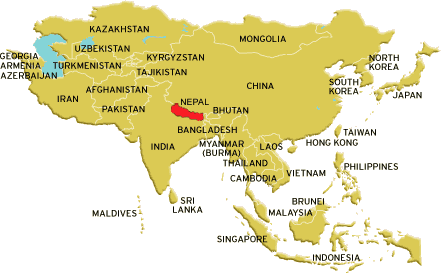Tamang are an ancient and major indigenous people of Nepal.During the 8th century the Tibetan King employed Tamangs as border patrol to protect the people and lands of Tibet. In Tibetan, the word Tamang means: 'Horse Warriors'. As such, they lived around the southern Himalayan region.
Before the creation of Nepal, Tamangs occupied the Terai Hills in the 7th century. Nepal, was formed later in the 18th century and saw a slow assimilation of the Tamang group with other communities in the region. Around the 18th century following conquests from other communities, the land owned by Tamangs were taken away and distributed to the new rulers of the region.Tamangs are mostly believe in 'Bon' Dharma which is one of the Buddhist releigion and are known as Buddhist cultural and cultural system. Which have a system of six types of societal leaders: Tamba, Ganba, Bonbo, Labonbo, Lama and Choho--to keep the Tamang society continuously alive and dynamic. The six have their respective and important roles to play in the development of Tamang society. The Tamba looks after the cultural aspect and has a very important role to play in marriage ceremonies. The Lama carries out death rites (Ghewa) and undertakes activities related to the Buddhist religion. The Bonbo propitiates the local gods and goddesses and assists by providing treatment to the sick and needy in the village. The Labonbo (Laptaba) keeps alive the history of the clan and lineage through the worship of clan deities. As each thar, or subgroup, has its own Phola or clan deity, there are different Labonbos for each and every subgroup. The Choho looks into cases and dispenses justice and maintains peace, security and wellbeing in society. The Ganba participates in all types of social, political and religious activities. He observes the various activities of society, including whether the Tamba, Bonbo, Lama, Labtaba, Choho, etc have fulfilled their functions as prescribed by rituals and to the best of their ability or not, and evaluates the activities and gives his suggestions. Thus, the six societal leaders or actors continue to make the Tamang society aware of its duties and responsibilities. There are also in Tamang society traditional institutions like Nhangkhor active to undertake socio-cultural activities. Their traditional area is the hilly region between the Budhigandaki river and the Likhu river. At present, they live in large numbers in the districtmans which is surroundingly spread (Kathmandu valley) of Rasuwa, Nuwakot, Dhading, Makawanpur, Sindhuli, Ramechhap, Dolakha, Lalitpur, Sindhupalchok and Kavrepalanchok in the Central Development Region. They are also scattered all over the country, and outside Nepal they are found in large numbers in Darjeling, Sikkim, Asam and Nagaland of India and in Burma and Bhutan. The total population of Tamang in Nepal, according to the census of 2001, is 1,282,304, ie 5.6 per cent of the total population of the country. The Tamang language occupies fifth place in the country in terms of the number of speakers speaking any one language and first place among the Tibeto-Burman languages.
As this Tamang people should be ahead in nation but Unfortunately, many years of marginalization and discrimination have hindered the progress of the Tamangs. But despite facing several hardships they have survived to maintain their distinct identity and recent years have seen some developments.
































